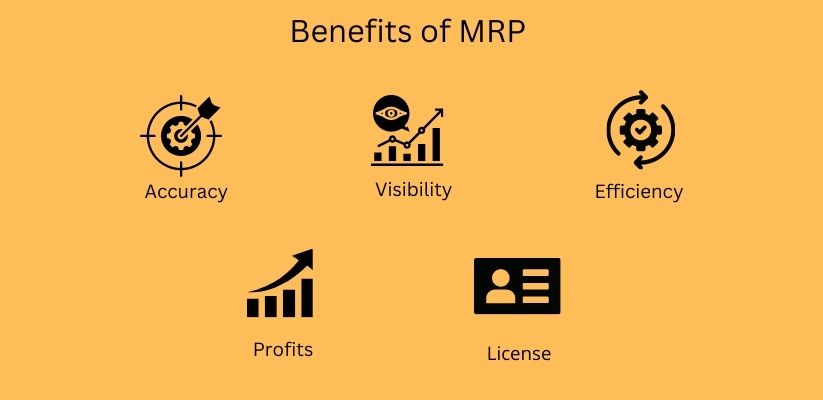Summary- MRP Material requirement planning is a system that helps businesses plan and tracks the number of materials they will need to produce their products. It considers the quantity of each material required, the lead time for each material, and the production schedule. This helps businesses ensure they have enough materials to meet their production needs.
What is MRP?
MRP stands for Material Requirements Planning. It is a system that planners use to calculate the number of materials needed to produce a product. This system considers the number of expected products sold, the lead time for ordering the materials, and the stock on hand.
Material Requirements Planning MRP has many benefits, including an improved inventory management system, reduced lead times, and improved communication. With MRP, businesses can better plan and manage their inventory, ensuring they always have the needed stock. Material Requirements Planning also helps reduce lead times, meaning that products will reach customers faster. MRP also helps improve business communication, allowing for a more efficient flow of information.
<< Also Read: What is a Bills of Material (BOM)?>>
What are the critical components of MRP?
The critical materials and components of MRP requirements planning are materials, production, and inventory. The materials component includes the purchase and production of materials, while the production component includes the actual production process. The inventory component manages finished goods, work-in-process, and raw materials.
How does MRP work?
MRP is a production planning method that uses the master production schedule orders to calculate the number of materials needed to produce a desired quantity of products. The Material requirement planning system uses the bill of materials (BOM) for each product to calculate the required amount of each component. The system then determines the required quantity of each element for all the products scheduled for production and calculates the total amount needed.
What are the challenges of MRP?
One of the main challenges of material requirements planning is its reliance on accurate data. The MRP system will not produce accurate results if the data is inaccurate. This can cause problems with inventory, production, and delivery.
Another challenge is that Material Requirements Planning MRP can be expensive to implement and maintain. It requires a lot of up-front planning and resources to set up and run correctly.
MRP can also be difficult to use. It can be complex and challenging to configure and operate. It makes it tough for the users to get the most out of the system.
Material requirement planning can be challenging to integrate with other systems. It can be difficult to get the MRP system to communicate with other systems in a way that produces accurate results. This can cause problems with inventory, production, and delivery.
How can you overcome the challenges of Material requirement planning?
Many challenges can come up when using MRP, but with careful planning and execution, most of these challenges can be overcome.
The biggest challenge is ensuring that the Material requirement planning system’s information is accurate and up-to-date. This means that the system must be regularly maintained and updated and that all relevant data is entered into it.
Another challenge is ensuring that the MRP system is used correctly. This means that everyone who needs access to it must be trained on how to use it and that it is used consistently across all departments. Moreover, it is vital to ensure that the Material Requirements Planning MRP system is not overused or relied on too heavily, as this can lead to bottlenecks and disruptions in production.
By considering the specific challenges that can come up with MRP, and planning accordingly, most of these challenges can be overcome.
<< Also Read: Benefits of Material Management in ERP>>
How can MRP be improved?
There are many ways that Material requirement planning can be improved. One way is to ensure that the data in the system is accurate. This can be done by regularly cleaning and updating the data and verifying it against other sources. Another way to improve Material requirement planning is to make it more user-friendly. It can be done through the navigation and by offering users more help and support.
Additionally, material requirements planning can be improved by making it more flexible. This can be done by allowing users to customize it to their needs and providing more scheduling and planning options. Requirements planning MRP is improved by increasing its speed. This can be done by optimizing the algorithms and using faster hardware.
Material requirement planning is an essential tool for businesses that helps them ensure they have the materials they need to meet their production needs. It can help companies to stay supplied with materials, leading to missed production deadlines and lost profits.
Manufacturing Resource Planning is a system that helps businesses to forecast and manage their production processes. It can provide several benefits, including improved efficiency, customer service, and reduced waste.
What are the benefits of MRP?
There are many benefits to using MRP software in your business. Some of the key benefits include improved accuracy, improved visibility, and improved efficiency.
With improved accuracy of Material Requirement Planning, you can be sure that you are ordering and producing the correct quantities of items. This will help avoid stockouts and overages, which can be costly.
With improved visibility, you can see where your inventory is, what is produced, and what needs to be ordered. This information is available in real-time, so you can make quick and informed decisions about what to have and when.
You can streamline your production process with improved efficiency and ensure everything runs as smoothly as possible. This will help you to save time and money.
Overall, Material requirement planning software can provide several benefits for your business. It can help you improve accuracy, visibility, and efficiency, leading to increased profits and a more successful business.
How can Material requirement planning improve your business?
MRP can improve your business by helping you plan, schedule, and control inventory flow through your organization. It can also help you to make a better conclusion on what to and how to produce it. Additionally, MRP can improve your customer service by ensuring you have the right products available when your customers need them.
Material Requirements Planning can be a precious tool for businesses of all sizes. By helping to streamline production, it can lead to improved efficiency and a more competitive edge. Additionally, it can help to ensure that customers receive the products they need promptly and reduce the amount of waste produced in the manufacturing process.
What are the critical differences between MRP and ERP?
MRP and ERP are two popular types of business software. Material requirement planning is a manufacturing resource planning system, while ERP is an enterprise resource planning system. Both systems can be used to manage a company’s resources, but they have key differences.
MRP is typically used in manufacturing companies, while ERP is used in a broader range of businesses. MRP is focused on managing the production process, while ERP is focused on the entire business, including production, finance, marketing, and sales.
MRP is a more limited system than ERP. It only handles a particular number of transactions and is not as versatile as ERP. ERP can manage a company’s entire operations, including multiple locations and currencies.
Material requirement planning typically costs less than ERP. It is a more straightforward system that does not include the same features as ERP. ERP is a more complex system that can handle various tasks.
MRP and ERP are both valuable tools for managing a company’s resources. However, businesses should know the critical differences between the two systems.
<< Also Read: Difference Between Discrete and Process Manufacturing?>>
Which is better for your business: MRP or ERP?
It is tough to conclude which would be the best system since it depends on your specific needs and requirements. However, here is a basic overview of the differences between MRP and ERP systems:
Material requirement planning systems are focused on material requirements planning and are specifically designed to help businesses manage their inventory and production. ERP systems are more comprehensive and can provide various features such as financial management, HR management, and customer relationship management.
If you seek a system that might help you manage your inventory and production, then Material requirement planning is the better option. If you need a more comprehensive system that can provide a range of features, then ERP is the better option.
MRP and ERP are both essential business tools, but they serve different purposes. Material requirement planning is focused on manufacturing and inventory management, while ERP is focused on finance, accounting, and other administrative tasks. Understanding the difference between these two is essential to choose the right one for your business.
Sage Software Solutions is a leading IT company with an array of advanced ERP Software solutions. Our proprietary products — Sage X3 and Sage 300 will help you cut your operational expenses, improve business productivity, increase operational efficiency, forge robust customer relationships, and strengthen association with vendors, suppliers, and distributors. So, if you are looking to reinforce your business fundamentals and emerge as an industry leader, then please schedule a call with one of our sales representatives.





